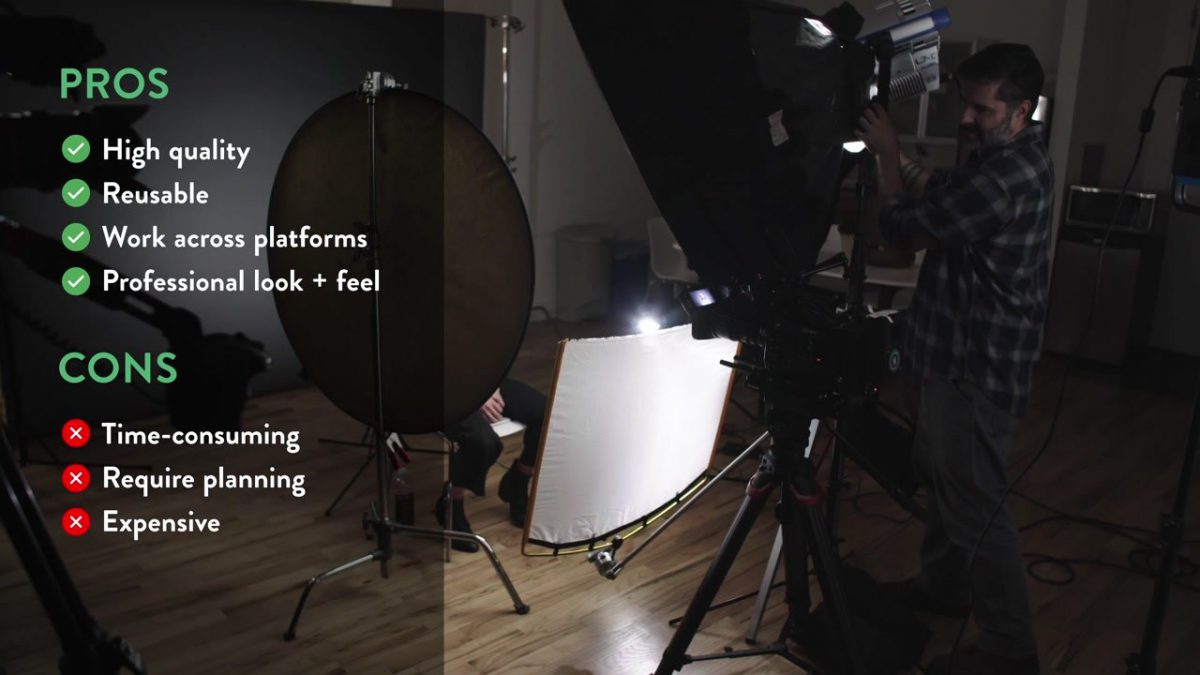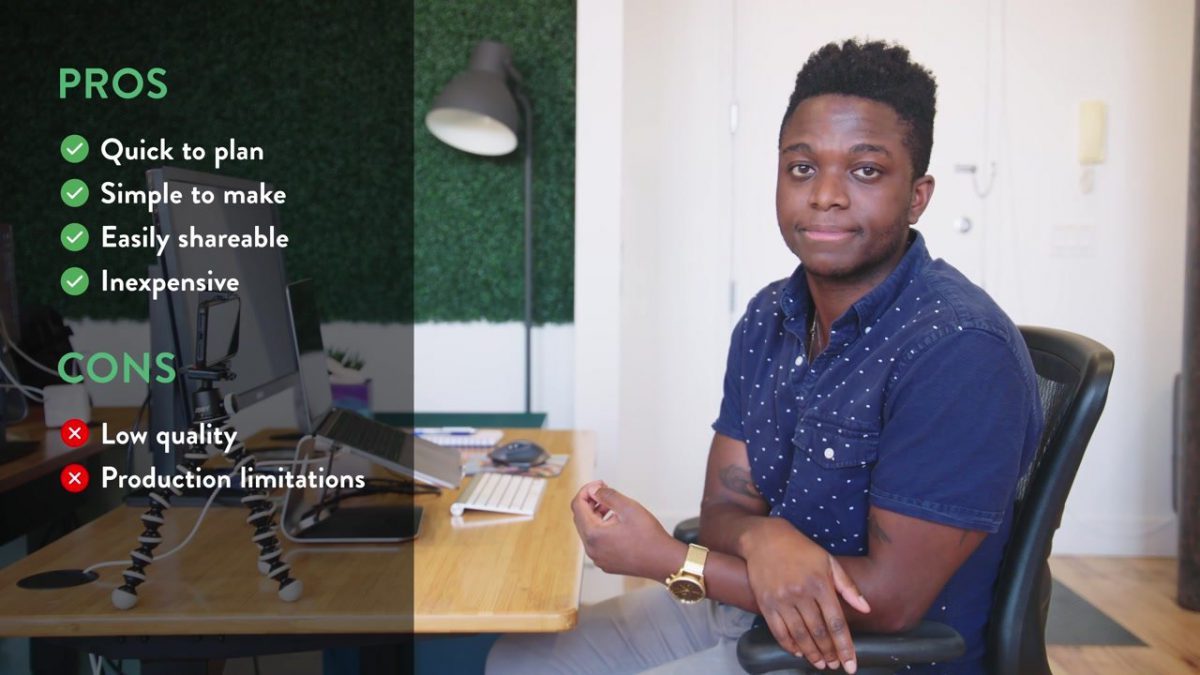When should you grab your phone to film a quick video, and when should you invest much more heavily in production? As phones become more and more capable of recording high quality video, it can be hard to know which direction to take.
In this blog, we will be discussing the differences between polished videos and off-the-cuff videos. We’ll look at how we define both styles of video, the pros and cons of each, and explain why you might choose one over the other.
What’s the Difference?
In this video, Ikey Ajavon, a marketing content strategist at SproutVideo, breaks down the distinctions between off-the-cuff videos and polished productions. Learn the benefits and drawbacks of each, as well as what’s required to make your own.
What is a Polished Video?
Most people are already familiar with polished videos. For many companies, this is the only type of video they produce. And for good reason – they have a very professional look and feel, and can be used in many different ways.
For instance, polished videos are perfect for advertising and marketing videos, demo and explainer videos, in-depth interviews, branded shows, and more. You can share such videos in advertising campaigns, on your website or blog, or post them to social media.
Pros and Cons of Polished Videos
There are plenty of benefits when it comes to polished videos. They are generally reusable, they can be shared almost anywhere, and they ensure you will get that professional look. Investing in your video production can also pay dividends in terms of viewer engagement and brand-building.
Of course, there are some drawbacks. These videos are usually very time-consuming, expensive, and require a lot of planning to produce. If you don’t have a reasonable budget or plenty of lead time, polished videos are likely out of the question.

How to Make Polished Videos
For this type of production, you’ll need a few key components to get the best results. First, you’ll need a script, actors, and probably a location for your shoot. Depending on the video, you’ll also need props, lights, and microphones. Next, you’ll want to ensure you have the right camera for the job.
We recommend using a DSLR or mirrorless camera at the very least. A camcorder or cinema rig will ensure even better quality if you have one. For more on picking the right camera for your project, check out our comparison of the real world features that matter for different cameras.
If you have an in-house marketing or video team, they might be able to produce this type of video. Otherwise, you’ll need to hire a video production company. The level of technical expertise involved usually requires the assistance of video professionals with hands-on experience.
For post-production, if you’re handling it in-house, we recommend using industry-standard tools such as Premiere Pro, After Effects, DaVinci Resolve, Audition, and other applications to ensure the final product is top-notch. If you’re working with a production company, they should be using professional video editing software.
Why Make Polished Videos?
So, why would you go through all this “trouble” for a polished video? As mentioned earlier, this type of video will last for a long time and can be used for multiple situations. They also reflect well on the quality of your company or product.
In some regards, polished videos also feel like a safer option. They scripted and heavily produced. You’ll have plenty of chances to correct any issues before the video is shared.
In certain cases, your video needs to be polished to get the look you desire, such as with multi-camera interviews. When working with more than one camera, the footage really needs to match, or the result will feel disjointed and be very distracting for viewers.
Due to the complexities of operating multiple cameras at the same time, you can’t shortchange the production. In cases like this, it’s best to plan on a higher quality production from the get-go to ensure the final result turns out the way you want.
What is an Off-the-Cuff Video?
Off-the-cuff videos are essentially the opposite of polished videos. They generally require much less planning, far fewer resources, and are much faster to produce than polished videos.
Anyone can produce this type of video, and it’s everywhere online. While many brands are still wary of testing this format, it’s becoming more and more commonplace to see major companies producing and sharing off-the-cuff videos.
Examples of off-the-cuff videos include short interviews, timely updates, or social media-specific videos like Instagram stories. You mainly see this style of video on social media sites like Facebook, Instagram, Twitter, and LinkedIn.
Pros and Cons of Off-the-Cuff Videos
Off-the-cuff videos are quick to plan, simple to produce, inexpensive, and easy to share. They’re an important part of most companies’ marketing strategy since they feel authentic and help forge connections with viewers.
However, just like polished videos, off-the-cuff videos have their weaknesses. With limited control over production, and lower quality overall, off-the-cuff videos aren’t always appropriate for every type of video.

As a result, they have a shorter shelf-life. They aren’t as evergreen as polished videos, and are unlikely to have much value over the long run.
How to Make Off-the-Cuff Videos
Creating an off-the-cuff video is very straightforward. You won’t need actors or outside companies to produce it. Your marketing team (or anyone in your office who is willing to be on camera) should be able to handle the entire process.
The overall look you’re going for is much more casual than with a polished video. Natural light sources and everyday hair and makeup are perfectly appropriate for these types of shoots. Of course, it never hurts to wear a clean shirt.
For recording off-the-cuff videos, any relatively new smartphone will be just fine. If you have a point-and-shoot, DSLR, or mirrorless camera, any of those options would work even better than a smartphone, and elevate the quality.
The last step is post-production. Depending on the video, you might not need to edit anything at all.
If you need light editing, there are lots of apps in the App Store or Google Play store that allow you to edit efficiently right on your phone. Apps like iMovie, InShot, Splice and more are an excellent place to start. If you would like to edit on a computer, we’d suggest using Adobe Rush, which is a scaled-down version of Premiere Pro with an accompanying mobile app.
Why Bother With Off-The-Cuff Video?
You might be thinking, why would I sacrifice the quality of a polished video for an off-the-cuff video? Well, these videos can foster a strong feeling of authenticity for the viewer specifically because they look and feel less produced than a polished video. They read as much more personal than a typical marketing video.
As a result, they are particularly well-suited for timely or live updates from an event or product launch, or for creating interesting behind-the-scenes content. Any time you need to quickly get the word out to your audience, an off-the-cuff video is likely the way to go.
They also allow for a much more casual approach to your content. They don’t have to be perfect or replicable – in fact, that’s the entire point.
It really is the more the merrier when it comes to off-the-cuff video. Since each individual video has a short shelf-life, producing them on a frequent basis is key to success with this style of video. That way, you can build an engaged audience over time.
Best of Both Worlds?
We think there is one type of video that works well in both categories: internal communications. For company updates that happen on a recurring basis, we’d suggest keeping it off-the-cuff, low-cost and quick. Examples include quarterly sales results or a welcome video from the CEO for new hires.
Basically, you want those videos to feel as personal and real as possible, and they inherently require a quick turnaround time. Those factors make off-the-cuff videos the right choice.
On the other hand, if your company is expanding rapidly and the training material won’t be changing in the near future, it might be worth the time and effort to produce a polished video to give new hires the best first impression. Similarly, a year-end company performance review might be worth spending more time and effort on.
When deciding which direction to take for your internal communications videos, consider the intended shelf-life of the video, the audience, and the time and resources available to you.
Whether you’re producing more polished content, sticking with off-the-cuff videos, or a combination of both, we’d love to hear how you’re implementing video to improve your business. Let us know in the comments below.








